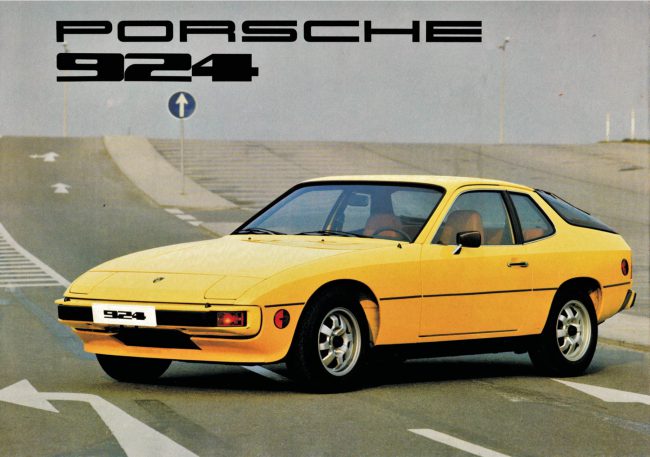
Before the 944, there was the 924. Originally it was planned as a VW-only model to replace the 914. It was designed by Porsche and used many more VW and Audi parts than its predecessor, at Volkswagen’s request. After everything had been designed and engineered, and was essentially ready for production VW backed out of the deal. Nice. So Porsche decided to sell it themselves, though VW contracted to build the cars for Porsche. It was introduced for the 1976 model year.
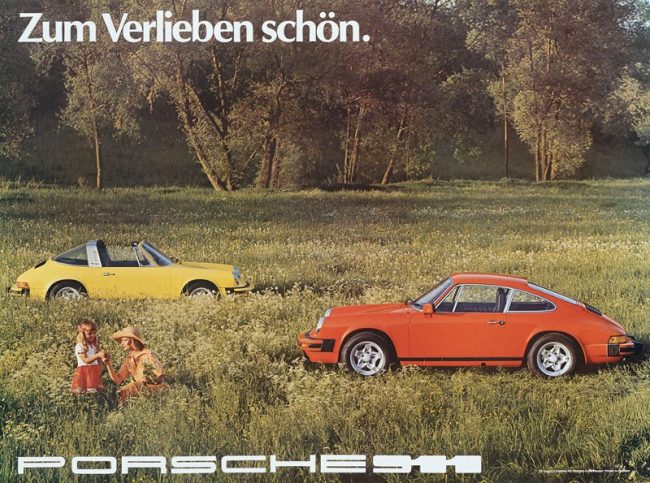
While the car was graced with the Porsche name, that did not translate into tire-burning performance. The inaugural 924 was equipped with the 2.0L VW/Audi inline four-cylinder engine with Bosch K-Jetronic fuel injection and a four-speed manual transmission. The 924 was praised for its handling but was not fast, with North American-market cars having only 95 horsepower. If you wanted fast, you needed to go 911.
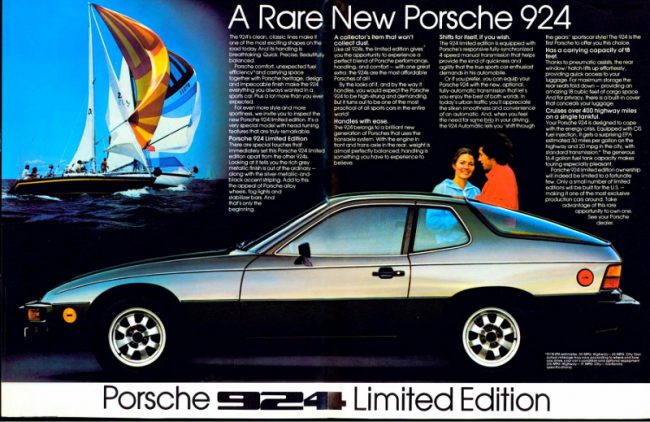
Power was steadily increased, however. The addition of a catalytic converter halfway through the 1977 model year bumped horsepower to 110 and a three-speed automatic transmission became available as an option, the first Porsche ever available with a slushbox. A new model, the 924 Turbo, came out in ’78 with a 10-psi boost resulting in 170 hp. Finally, the car had some decent power.
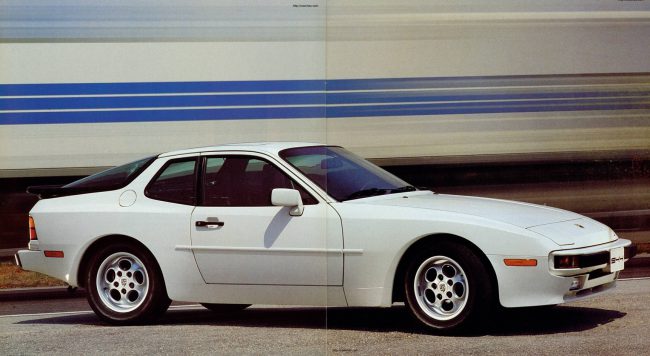
1987 944
A special homologation version of the 924 Turbo, the 1980 924 Carrera GT, would pave the way for what would become the 944. 406 were built to certify the model for racing and included plastic front and rear fender flares, front and rear spoilers and an intercooled, 210 horsepower version of the 924 Turbo’s engine.
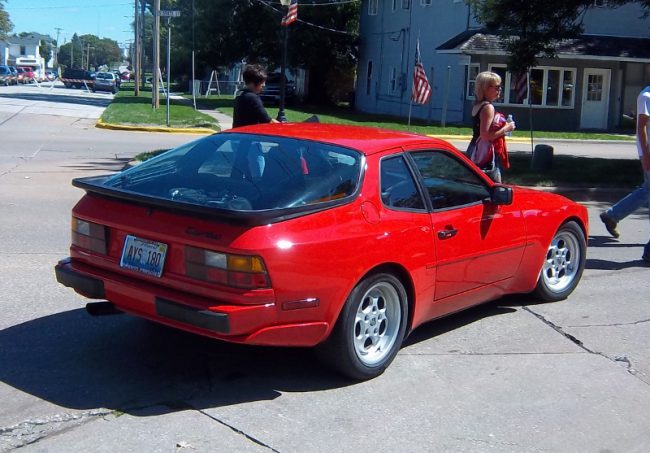
944 Turbo spotted at the September 2012 Geneseo, IL car show.
In 1982, the 944 appeared, looking very much like the Carrera GT but with steel fender flares and a normally-aspirated 2.5L 150 hp engine. The engine was no longer supplied by VW-Audi, being an all-new design that used half of the 928’s V8 as a starting point.
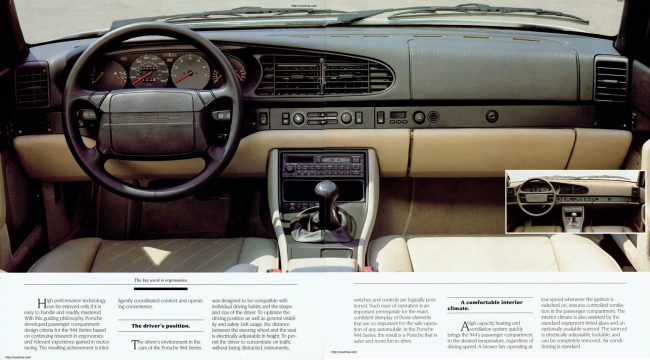
1987 944 instrument panel
Now the car had more muscular looks to match its improved performance. In 1985, the 944 got an attractive new instrument panel, finally replacing the one that had been on the car since its introduction.
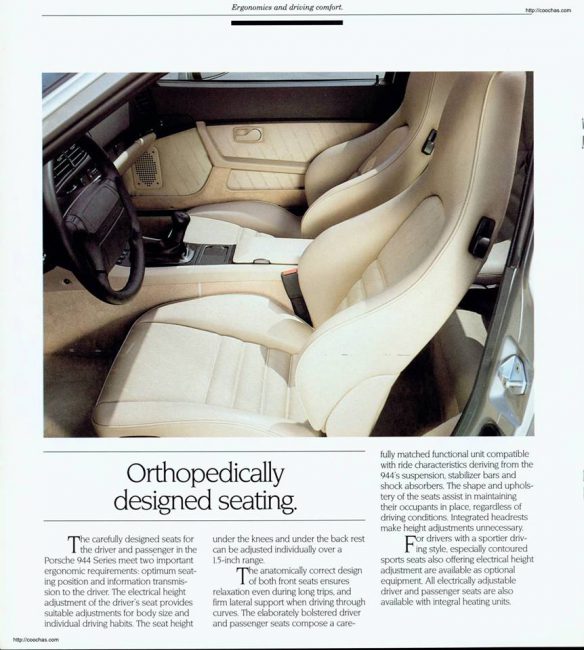
1987 944 interior
The big news, however, came in 1986 when the 944 Turbo was introduced. It used the same 2,479 cc engine as the standard 944, but with an intercooled turbocharger that produced 217 hp at 5800 rpm and 243 lb-ft of torque.

Zero to sixty came in 6.1 seconds and top speed was 152 mph. For all this performance, fuel economy was not bad, being rated at 19 city and 27 highway.
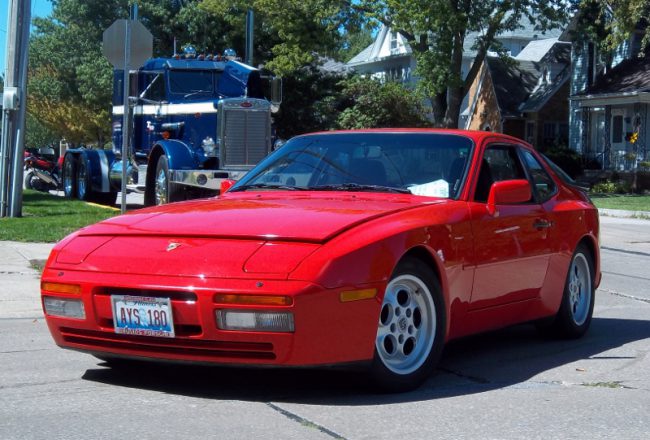
A smoother front fascia with integrated fog lights and an underbody spoiler beneath the rear bumper improved aerodynamics, resulting in a drag coefficient of 0.33 and a frontal area of 1.89 square meters.
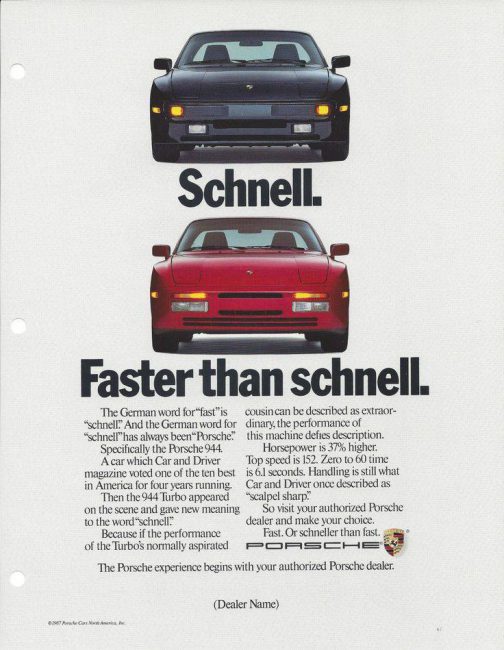
Non Turbo models retained the earlier nose with black, 5-mph bumper.
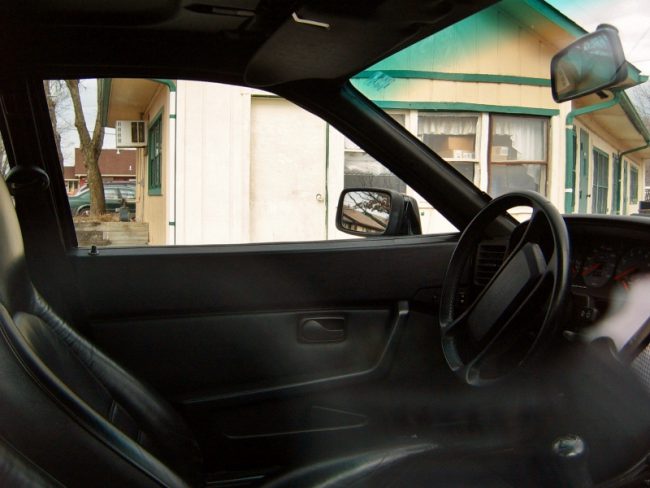
Interiors were suitably sporty, with leather bucket seats, console and full instrumentation, including a boost gauge. The 944 Turbo was the top of the line, so power windows, seats and a nice stereo were included. The Porsche 944 also has the distinction of being the very first production car with dual airbags.
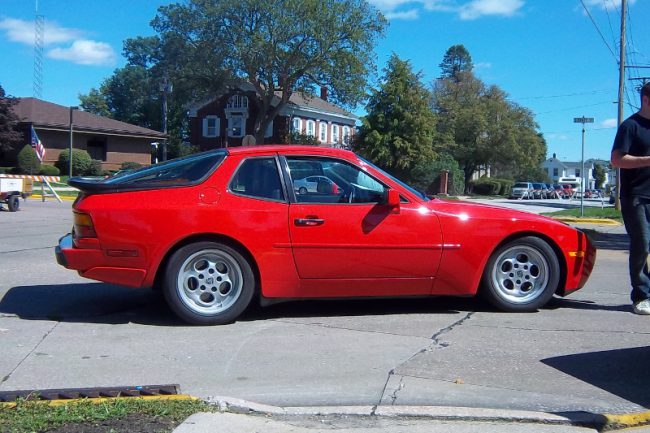
They were introduced for 1987. Other than adding a convertible version for 1989, the 944 would continue in the same basic format until 1991. It was heavily facelifted with a 928-esque front end and became the 968 for 1992-95.
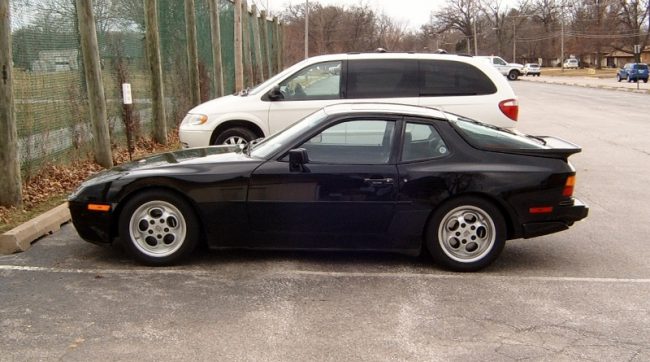
This 944 found me back in early 2012. I had just left my place and was slowing down for a stop sign when I saw this Turbo sitting in the parking lot of the local golf course. As I’ve always been partial to Porsches, I had to stop and check it out. This one appeared to be an ’86 as it didn’t have the airbags.
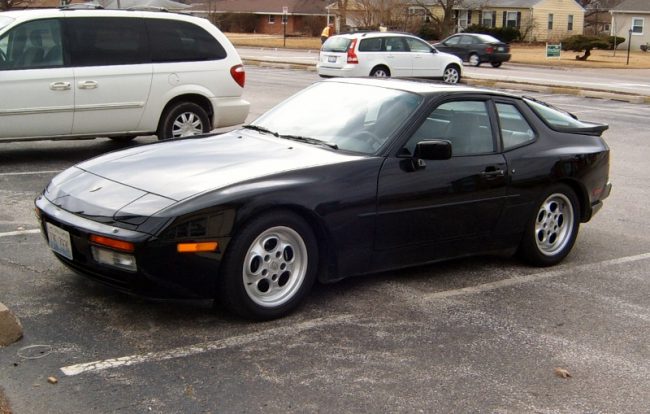
It was in very nice shape. With the exception of an aftermarket stereo, it was all original as well. The owner is clearly a Porsche nut, judging from the PCA decal in the rear quarter window. For a time in the late ’90s, these were seen as cheap fun, and I saw quite a few 944s at the time that had clearly had the bark beaten off of them. I hadn’t seen one in quite a while, so was happy to spot this one in basic black. Porsche may not have planned on having the 924 and its derivatives in their lineup, but with a nearly 20-year production run, it worked out pretty well in the end.
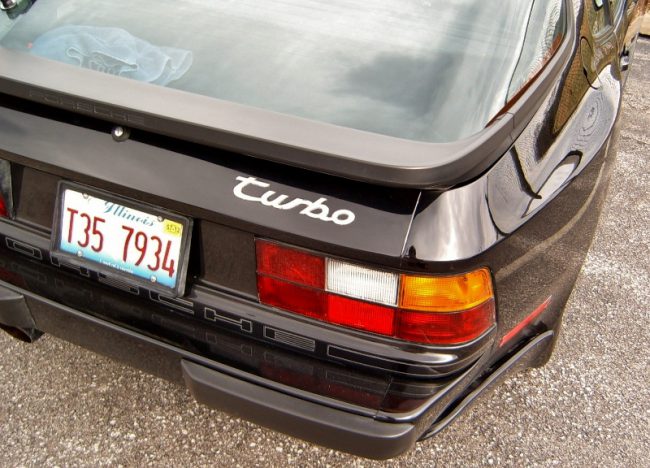








11 Comments
Probably the best midlife restyle ever even if Germany kept making the 924 with the 2.0 through 1985 for Europe.. The 2.5 four was interesting they realized they would need balance shafts and licensed the Mitsubishi 2.6. When they got into the 2.6 they realized what a pour installation it was. The Porsche 2.5 prototypes without the shafts ran smoother than the 2.6 with them. They then designed a better installation and the rest is history. Interesting how things work with honest competent engineers. Licenses get paid and then better engineers make it better. As the 944 faded and Porsche faced one of it’s dark periods, they cut costs dramatically and put a brave face on it by claiming they were learning efficient production from Japan. Is that what they were learning?
Half a V-8 to make an “economy” 4 is nothing new as Pontiac cut their 389 in half in 1961, but their version would have surely benefited from a balance shaft. Amazing how auto tech and progressed, I drooled over the performance figures of 944 Turbos when new, but now a base Accord will give it a good run for the money without the expensive Porsche maintenance regime.
Exactly… I spent two years shopping for a 944 before I realized: 1. previous owners usually haven’t done regular maintenance 2. virtually every car for sale needs expensive repairs 3. the 944 is slower than a Mazda MX-5 Miata and really doesn’t handle that well 4. Porsche 911 owners will always look down on you, cos it still really isn’t a “real” Porsche, even after more than three decades. 5. they can be bought for really cheap because you’ll spend $5K to $10K on repairs the first year you own it 6.you can buy a mint condition 944 and it will STILL need expensive maintenance on a regular basis. Because of these considerations, I decided to buy a used low mileage Miata instead.
All you say is true, but if Miss Christina drove a MX5 through the boomtown, would satisfaction still ooze from her pores, probably not.
No way in Hades will an Accord of any stripe feel like a 944. You can apply that sort of that logic to any number of older performance vehicles – up to and including Ferraris, 911 Turbos (and certainly including C2 Sting Rays), etc. It’s about the driving experience and feel, not the performance numbers. My wife’s ’13 Outback 3.6R will outperform my base 944 from a numbers standpoint – in fact, my son’s 07 TSX probably will too – but so what? The 944 is so harmonious, connected and solid that is a pure joy to drive and own.
And 944s don’t “handle that well”? I couldn’t disagree more. All that said, I don’t disagree that there are a lot of junky 944s out there as a direct and proximate result of being “Porshs” that any idiot could afford to buy. I also don’t disagree that they can be expensive to get up to snuff – but they certainly don’t have to be, and, if you look, there are plenty of solid, reliable and well maintained examples out there such as the ’87 my buddy picked up a couple years back. My ’83 (owned since 1991) has required a few cash infusions over the year, but nothing at all crazy or of the magnitude posited here. Its original Pasadena Yellow paint still looks gorgeous. It has been and remains a fantastic and reliable vehicle, and, IMHO, a bargain,
This was my post-college, first career, early marriage dream car. I’d always liked the 924 and 944. Add a turbo, and instant lust! But, it never worked out. After marriage, came the house, the other car, and then kids. FWIW, I had a couple of Mercury Capri 5.0L at the time, so it wasn’t like I was starved for fun. But, a 944 Turbo would have been a blast.
The 90’s came, raising kids, trading jobs, switching houses, relocating. I saw these cars go from new to used to trashed to impossible to find. Now, they’re an old Porsche with a maintenance regime I’d rather not deal with. If I wanted something small and fun with a turbo, I’d probably look into a Fiat 500 Abarth. I could daily it all year long, too.
Sometimes, I like to fantasize about buying one of these and stuffing a LS- or LT- motor in it (yes, I know, boo!). All the fun of the mighty Chevy V8 with the handling and poise the Camaro could never quite manage.
I had the Japanese copy of this car–the Mitsubishi Starion Turbo: silver with black leather interior. I bought it from a cute girl I knew whose Daddy gave it to her as a high school graduation present. The most memorable quality about the Starion was the girls it would attract. I wish I had kept it longer although it had a tendency of pushing the dipstick out of its usual resting place.
I also found out in my Mitsubishi that anti-lock brakes don’t help when cornering. I slammed into the curb on an entrance ramp when the boost kicked in suddenly. This was the first car I ever had with anti-lock brakes.
In hindsight it was a great car for me. It looked great was comfortable and made me appear more successful that I was. As Oscar Wilde put it, “It is pity youth is wasted on the young.”
I believe the Starion anti locks were rear wheel only.
I believe you are correct.
Did I miss the perrennially true comment that these cars have incredibly age-resistant styling? They still look modern. Yes, the pop-up lights are dated and I never cared for the five whole wheels, but on the whole the design has not grown stale.
That 944 Turbo looks exactly like my first Porsche, a black on black Turbo with phone dial rims. I bought it in 1997 for an amount I thought was absurdly cheap – it was sitting under a pile of boxes in a mechanic’s shop on the west side of Chicago. It turned out to have aftermarket chips and boost control, and was probably throwing off 275-325 horses at the crank. I did autocrosses and track days in that car, drove it up Pikes Peak, and moved cross-country in it in 2001. It punched well above its weight, performance wise.
I learned never to buy a cheap Porsche, as it ended up costing me probably twice as much in repairs as a good, well-sorted version would have cost to purchase. But I’ve found it awfully hard to find a car that is more connected and engaging to drive, and practical to boot. 944s are just about the perfect weekend runabout. I replaced the black Turbo with a Silver Rose Turbo S, and I’ve had at least one 944 in the garage ever since.